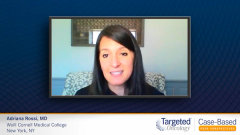
Management Challenges in TCR MM
An expert in multiple myeloma provides insight on the treatment challenges for patients with triple-class refractory disease, particularly after fourth or later lines.
Episodes in this series

Adriana Rossi, MD: Reviewing all of the findings for this case, I think a few important things show up. This patient has now been exposed to IMiDs [immunomodulatory drugs], proteasome inhibitors, and an anti-CD38 antibody, and is what is now called a patient with triple-class refractory multiple myeloma. It’s not an uncommon case, especially in the academic world where I am at a tertiary referral center. Many patients who come to me are exactly those patients who have had all of the easily accessible frontline medications and are now running out of standard options. I think it’s interesting to try to look at prognosis. We really don’t know at this point. The field is moving so fast; there are so many new agents coming up that are changing the landscape and changing the field. Last time we looked, I think back in 2017, and had data on proteasome inhibitor- and IMiD-refractory patients, we were expecting them to have an overall prognosis of about a year. But we now have a number of studies in these multiply refractory patients where we are getting deep and meaningful responses, not only CRs [complete responses], but MRD [minimal residual disease] negativity in the relapsed setting. I think that will absolutely translate to a survival difference. So we need more time to be able to see the effect this will have.
But it is challenging. This patient comes in with a significant clinical relapse. We often would monitor patients every month. Part of that is to not give time for the myeloma to get so unruly. If you are monitoring every month and you see signs of a biochemical relapse, where the M spike is going up but the end organ damage is not there, it gives you time to think and pick drugs, and hopefully prevent the damage. In this case, her anemia is quite severe, her renal function is impaired, and she has extensive bony disease. Part of what’s not addressed in the case is whether she has any antiresorptive therapy as part of her treatment plan. I would say any patient, not only those with lytic lesions, but all patients with myeloma, should have their chemotherapy complemented with either zoledronic acid or denosumab.
Transcript edited for clarity.
Case: A 75-Year-Old Woman with Triple-Class Refractory Multiple Myeloma
Initial Presentation
- A 75-year-old woman diagnosed with multiple myeloma 5 years ago returns to the clinic with complaints of extreme fatigue, increased muscle weakness and new bone pain in her right hip, right forearm and low back. She reports that she is currently taking antibiotics for a bacterial infection, her third in the last 12 months.
- Treatment history:
- Initially treated with DRd; CR lasting 20 months
- Switched to VRd, stable disease lasting 16 months
- Subsequently switched to KPd, achieved a PR lasting 12 months
- Started selinexor; follow up at 9 months showed M protein increase by 0.5 g/dl; patient continued to feel well
- Currently, 3 months after her last visit, she returns to the clinic for follow-up
- PE: new bony tenderness appreciated on right hip, pelvis forearm and lumbar spine; bruising and mild bleeding of the gums
Clinical Workup
- Labs: Hb 6.2 g/dL, calcium 8.4 mg/dL, LDH 160 U/L, creatinine 2.1 mg/dL, albumin 2.7 g/dL, b2 microgloblulin 4.9 mcg/mL, serum M-protein 4.2 g/dL, lambda free light chains 4.1 mg/dL
- HBV negative
- Skeletal survey and MRI revealed lytic bone lesions in the left hip, pelvis and L2 vertebrae and lytic lesions as well as a hairline fracture in the distal radius of the right arm
- Bone marrow shows 62% plasma cells IgG k
- FISH: t(11;14) at diagnosis; new del(17p)
- Diagnosis: R-ISS stage II MM
- ECOG 1
Treatment
- Initiated treatment with belantamab mafodotin









































